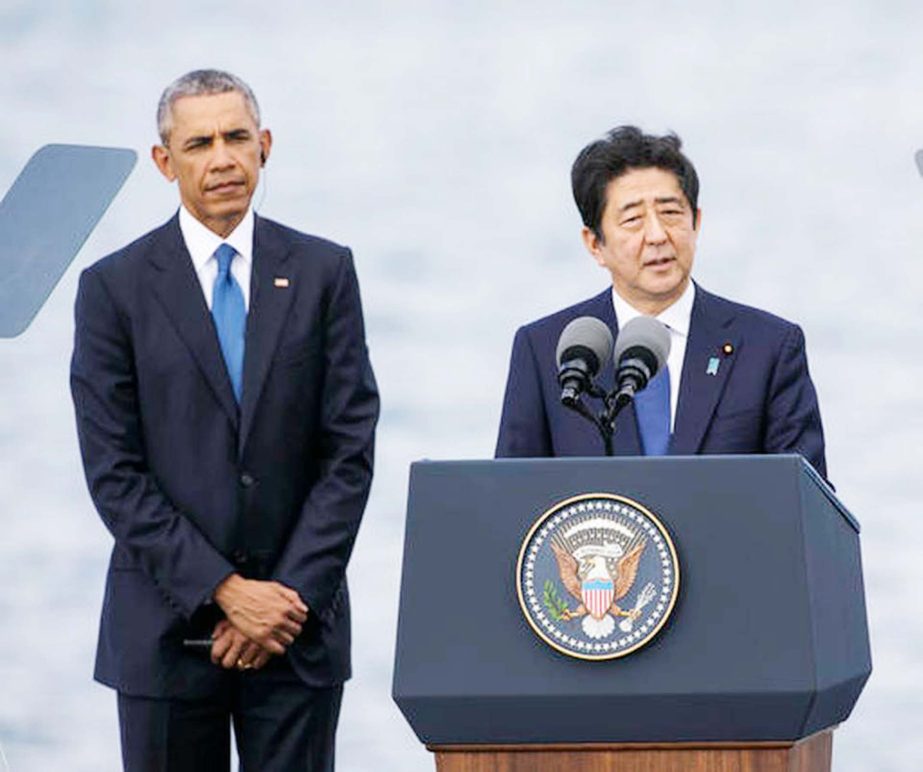
AP, Pearl Harbor :
The leaders of Japan and the United States sought to remind the world that even the most bitter enemies can become allies, during a historic pilgrimage to the hallowed waters of Pearl Harbor.
Prime Minister Shinzo Abe did not apologize, but conceded Japan “must never repeat the horrors of war again.”
Seventy-five years after Japan’s surprise attack, Abe and President Barack Obama peered down Tuesday at the rusting wreckage of the USS Arizona, clearly visible in the tranquil, teal water. In a show of respect for the war dead, Obama and Abe dropped purple petals into the water and stood in silence.
More than 1,000 U.S. war dead remain entombed in the submerged ship, which Japan struck as part of the devastating attack that killed more than 2,300 Americans and sent America marching into World War II.
“As the prime minister of Japan, I offer my sincere and everlasting condolences to the souls of those who lost their lives here, as well as to the spirits of all the brave men and women whose lives were taken by a war that commenced in this very place,” Abe said later at nearby Joint Base Pearl Harbor-Hickam.
That was the closest Abe would get to an apology for the attack. And it was enough for Obama, who also declined to apologize seven months ago when he became America’s first sitting president to visit Hiroshima, where the U.S. dropped an atomic bomb in a bid to end the war.
It was enough, too, for Alfred Rodrigues, a U.S. Navy veteran who survived the attack. The 96-year-old said he had no hard feelings and added, “War is war.”
“They were doing what they were supposed to do, and we were doing what we were supposed to do,” Rodrigues said before the visit.
In the years after Pearl Harbor, the U.S. incarcerated roughly 120,000 Japanese-Americans in internment camps before dropping atomic bombs in 1945 that killed some 140,000 people in Hiroshima and 70,000 in Nagasaki.
Since the war, the U.S. and Japan have built a powerful alliance that both sides say has grown during Obama’s tenure, including strengthened military ties. Yet there are questions about whether the relationship will fray under President-elect Donald Trump, a possibility neither Obama nor Abe addressed.
Abe, who became Japan’s first leader to visit Pearl Harbor with a U.S. president, said the visit “brought utter silence to me.” His remarks capped a day that was carefully choreographed by the U.S. and Japan to show a strong and growing alliance between former foes.
The leaders of Japan and the United States sought to remind the world that even the most bitter enemies can become allies, during a historic pilgrimage to the hallowed waters of Pearl Harbor.
Prime Minister Shinzo Abe did not apologize, but conceded Japan “must never repeat the horrors of war again.”
Seventy-five years after Japan’s surprise attack, Abe and President Barack Obama peered down Tuesday at the rusting wreckage of the USS Arizona, clearly visible in the tranquil, teal water. In a show of respect for the war dead, Obama and Abe dropped purple petals into the water and stood in silence.
More than 1,000 U.S. war dead remain entombed in the submerged ship, which Japan struck as part of the devastating attack that killed more than 2,300 Americans and sent America marching into World War II.
“As the prime minister of Japan, I offer my sincere and everlasting condolences to the souls of those who lost their lives here, as well as to the spirits of all the brave men and women whose lives were taken by a war that commenced in this very place,” Abe said later at nearby Joint Base Pearl Harbor-Hickam.
That was the closest Abe would get to an apology for the attack. And it was enough for Obama, who also declined to apologize seven months ago when he became America’s first sitting president to visit Hiroshima, where the U.S. dropped an atomic bomb in a bid to end the war.
It was enough, too, for Alfred Rodrigues, a U.S. Navy veteran who survived the attack. The 96-year-old said he had no hard feelings and added, “War is war.”
“They were doing what they were supposed to do, and we were doing what we were supposed to do,” Rodrigues said before the visit.
In the years after Pearl Harbor, the U.S. incarcerated roughly 120,000 Japanese-Americans in internment camps before dropping atomic bombs in 1945 that killed some 140,000 people in Hiroshima and 70,000 in Nagasaki.
Since the war, the U.S. and Japan have built a powerful alliance that both sides say has grown during Obama’s tenure, including strengthened military ties. Yet there are questions about whether the relationship will fray under President-elect Donald Trump, a possibility neither Obama nor Abe addressed.
Abe, who became Japan’s first leader to visit Pearl Harbor with a U.S. president, said the visit “brought utter silence to me.” His remarks capped a day that was carefully choreographed by the U.S. and Japan to show a strong and growing alliance between former foes.

